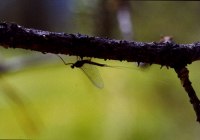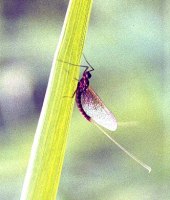 Sorting
out Mayflies Sorting
out Mayflies 
by Karen Christopherson |
Click
Here to read
more "Fish Tails" |
I don't think that it's just me who gets
confused by the assortment of mayflies out on the water, or mentioned in a
flyshop. References to nicknames, scientific names, or flies can get one
mighty confused as to what fly we should be using as a certain hatch is
on. Adding to the confusion is that, when you actually see a hatch, and
maybe two hatches, you ask, "which mayfly is that?". Of course
you can always throw on a fly that matches the size and color, but I
sometimes actually want to know which mayfly it is that's hatching.
Mayflies make up the order Ephemeroptera,
which is from the Greek "Ephemera" for
"short-lived" and "ptera" for
"winged". This aptly describes the mayfly's adult life. After
emerging as an adult, the mayfly lives from one hour to one day, during
which time its sole purpose is to mate and lay the eggs. Prior to this, it
has enjoyed almost one year as a nymph (if it could avoid those trout)!
 According
to Ward and Kondratieff, 11 of the 17 known North American mayfly families
are represented in Colorado. This includes 33 Genera and 71 Species. There
are something like 570 species in North America. Yikes! As a flyfisherman,
do you have to recognize 71 species of mayflies? Answer, "no",
but it will be useful to know a few of the Genera. Telling the species
apart is actually very difficult, especially when those mayflies are
flitting around and you have more important things to do (like fish). According
to Ward and Kondratieff, 11 of the 17 known North American mayfly families
are represented in Colorado. This includes 33 Genera and 71 Species. There
are something like 570 species in North America. Yikes! As a flyfisherman,
do you have to recognize 71 species of mayflies? Answer, "no",
but it will be useful to know a few of the Genera. Telling the species
apart is actually very difficult, especially when those mayflies are
flitting around and you have more important things to do (like fish).
Life Cycle
The mayfly has three stage of insect life - egg, nymph
and adult. It spends its life as an egg from an average of one to three
months, then as a nymph for 8 to 11 months. When the adult emerges, it is
first in a subimago stage (what we flyfisherpeople know as
"dun") - it is winged but can't mate. Soon (like hours), the dun
molts and becomes a true imago (translation "spinner").
The spinner mates, lays eggs, and dies. Falling on the water provides a
welcome feast for trout.
Recognition
Nymph mayflies have various habitats in the water as
either swimmers, crawlers, burrowers, or clingers. They are mostly brown
or black and have 2 or 3 tails.
Adult Mayflies are very distinctive in that they have
relatively large upright wings (for their body size) and long, extended,
upturned tail (actually 2 or 3 tails). They have a method of flying where
they seem to dart up and down in the air. The males will swarm, and the
female flies into this swarm.
The following table attempts to summarize some basic
information about the various mayflies found in Colorado and Wyoming.
Given are the scientific name (which many people will use to identify a
hatch), the common name (which many other people will use for a specific
mayfly), where in Colorado or Wyoming they are found, good dry fly
imitations, the nymph behavior, the colors of the adult (to help you in
identification), the time of year that they hatch, and the typical size of
the adult mayfly (given by hook size).
| Sci Name (Genus and
species) |
Common Name |
State |
Dry flies |
Nymphs |
Adult colors |
Time of year |
Size |
| Baetis vagans+ many others |
BWO (Blue-winged olive) |
CO+WY |
BWO, Parachute Adams |
swimmer |
olive/brown belly; greyish wings |
mar-nov |
16-24 |
| Ephemerella/Drunella guttulata +
grandis+ coloradensis |
Green Drake (western) |
western CO+WY |
green drake |
crawler |
grey-green, olive body; greyish wings |
jul-sep |
10-12 |
| Ephemerella inermis (smaller) +
infrequens (larger) |
PMD (Pale Morning Dun) |
CO+WY |
PMD |
crawler |
greyish wings; body varies |
jun-aug |
14-20 |
| Rhithrogena hageni+ robusta+ others |
Red Quill |
WY+CO (parts) |
Red Quill |
|
red/brown body; greyish wings |
jun-oct |
12-18 |
| Tricorythodes minutus+ stygiatus+
others |
Trico |
CO+WY |
Tricos, Parachute Adams, Royal Wulff |
crawler |
olive, black, brownish body; clear or grey wings |
jul-sep |
20-26 |
| Callibaetis americanus + many others |
Callibaetis |
CO+WY |
Callibaetis, cahill, |
swimmer |
light veins on dark wings; greyish body |
jul-aug |
14-16 |
| Ephemera simulans |
Brown drake |
nw WY+ nw CO |
|
clinger |
lt/dark brown body: splotchy wing |
may-oct |
8-12 |
| Rhithrogena morrisoni |
Western March Brown |
western CO+WY |
various Western March patterns |
clinger |
tan/brown body; mottled wing |
mar-apr |
10-14 |
| Drunella (Ephemerella) flavilinea |
Flav |
nw WY |
various Flavs (or small green dark patterns) |
crawler |
greenish body; greyish wings |
jun-aug |
14-16 |
| Heptagenia (various) |
Pale Evening Dun |
WY+CO (parts) |
PED |
clinger |
brownish body |
jun-aug |
14-16 |
 Flies Flies
Almost all mayfly nymphs can be imitated by a Hare's
Ear, Pheasant Tail, beadhead and flashback versions of these flies. The
RS2 is used to imitate BWO's, especially at emergence. The more important
aspect of nymphs is choosing the right size to match the mayflies on a
particular river, and to present it matching how the nymph behaves
(crawler, swimmer, clinger, burrower).
Adult mayflies can be imitated well by Adams, Royal
Wulffs, Humpys for almost all species with attention paid to size to match
the hatch. Else, most dry flies are named for the particular species or
its common name.
Refer to the Fly Tying page
for instructions on tying some of these patterns.
References:
- Ward, J.V. and B.C. Kondratieff, An Illustrated Guide
to the Mountain Stream Insects of Colorado, Univ. Press of Colorado,
1992
- Hafele, Rick and Scott Roederer, An Angler's Guide to
Aquatic Insects and their Imitations, Johnson Books, 1995.
- Mayfly
Central
- Earthlife
All information presented herein is to
the best of my knowledge and research. If you have comments or
corrections, please email me [email protected]
All photos (except top left at title)
copyrighted and courtesy of Hans
Weilenmann
|